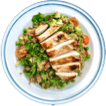
Interested in receiving new recipes?
Register your interest to access our free nutrition resources, recipes and information
We often hear about eating a healthy and balanced diet. But what do these two words mean?
Different foods contain different nutrients. For example, red meats provide protein and iron, green leafy vegetables provide folate and citrus fruits provide vitamin C. In addition, dairy foods provide protein and calcium, and wholegrains provide B vitamins and dietary fibre. Fats and oils provide energy and essential vitamins A and D. Eating a wide range of foods increases the chance of getting all the nutrients that our body needs to stay healthy.
It is a myth that older people need less nutrients than younger people. In fact, vitamin and mineral requirements may increase when sick. Older adults require more protein and generally should not be on low fat diets.
Have a look at the resource “Key nutrients for older adults” for more.

DISCLAIMER:
The content on this website is not, and is not intended to be, medical advice, which should be tailored to your individual circumstances. Content is for your information only, and we advise that you exercise your own judgment before deciding to use the information provided. Professional medical advice should be obtained before taking action. Please see here for terms and conditions.

Select your desired option below to share a direct link to this page.
Your friends or family will thank you later.